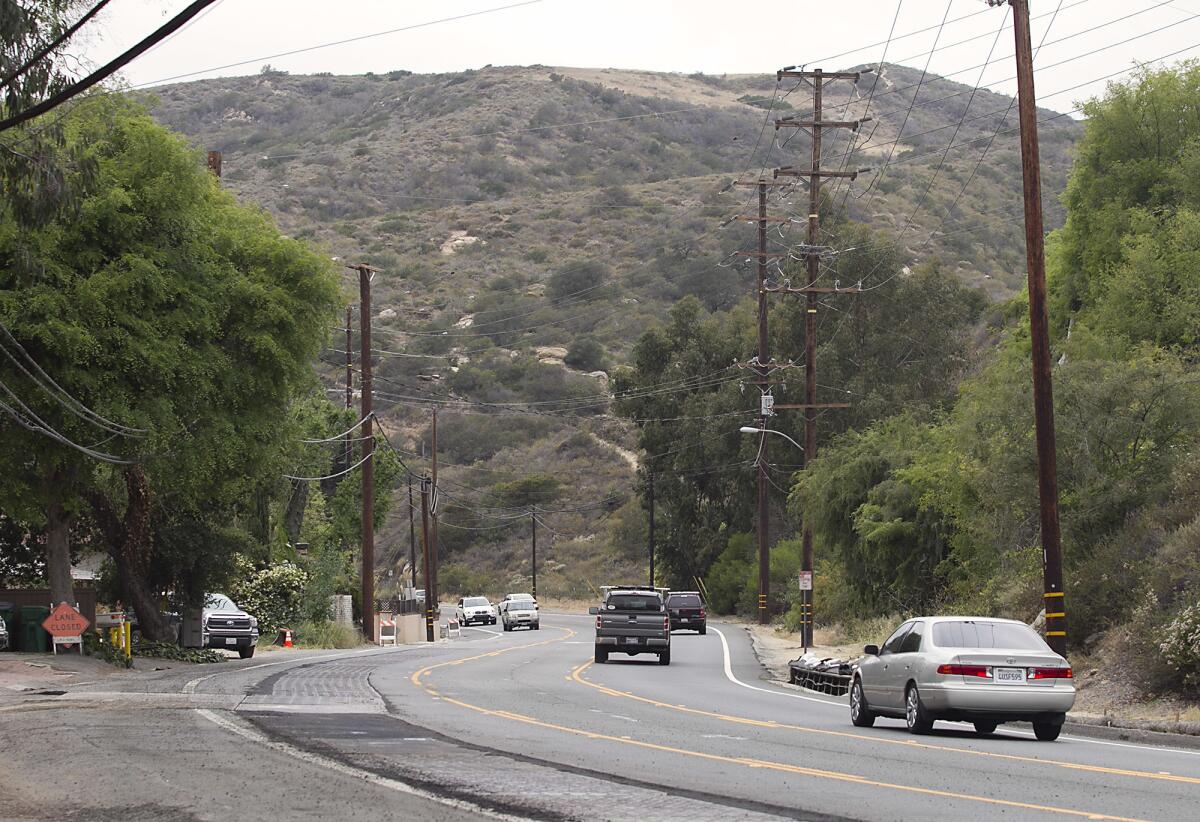Laguna plots strategy to put utility lines underground on major evacuation routes

A view from the Laguna College of Art + Design parking lot looking south along Laguna Canyon Road. The city wants to put utility lines underground along this and other major evacuation routes.
- Share via
The Laguna Beach City Council took a crucial step Tuesday toward removing all the utility poles and undergrounding the wires along Laguna Canyon Road and in other key parts of the city.
The council unanimously agreed to several recommendations that, in essence, form a game plan for removing overhead utilities on major evacuation routes in a city with limited egress that has dealt with fires and flooding. The poles are seen as a threat to safety since they are vulnerable to falling down under certain conditions, blocking roads and in some cases causing embers to fly and fires to ignite.
Traditionally the city has done undergrounding section by section, forming assessment districts under which residents agree to fund the costs of the work for their areas only. Tuesday’s move offers a more comprehensive view than the city’s piecemeal approach and depends in part on Measure LL money.
Residents in November approved the city ballot measure, which increases the transient occupancy tax rate, paid by tourists who stay in hotels and other lodging, from 10% to 12%.
Strategies outlined Tuesday address not only Laguna Canyon Road but Bluebird Canyon Drive, Thalia, Glenneyre and Monterey streets, Temple Hills Drive, Virginia Way and Coast Highway, according to a staff report.
Public Works Director Shohreh Dupuis said in an interview Wednesday that the undergrounding of these streets would cost an estimated $19 million.
She added that it would cost $42 million to underground the remaining utilities on Laguna Canyon Road — some work has already been done there — including removing 166 poles.
Removal of the poles on the canyon road, which is owned and operated by the California Department of Transportation, could allow for the creation of the pedestrian and bicycle paths long called for by residents.
“As I think about this problem, and my wife might say I obsess about it, it’s not just the fire risk,” Councilman Bob Whalen said. “Another possibility is an earthquake. If we have an earthquake that causes trees to fall and gas lines to rupture, there can be fires. If you have poles falling down in that process and blocking evacuation routes, it’s just an unnecessary risk.”
Whalen and Councilman Robert Zur Schmiede worked with utility companies, state legislators and other experts on the strategies outlined Tuesday.
Several residents at the meeting spoke favorably of the plan outline.
“I like the idea of using [Measure] LL money in identifiable ways,” resident Karen Klammer said. “It seems like you have the foundation for moving this ahead in a direct positive way.”
As part of its approval, the council directed staff to determine how the city could contribute funding beyond Measure LL to undergrounding in the neighborhoods.
The city expects to have up to $6 million available in the next four years, $3.4 million of which will come from Measure LL, Dupuis said.
Since Caltrans owns Laguna Canyon Road, the process requires the city to prepare a report that includes a preliminary roadway design with pedestrian and bicyclist improvements, along with expected costs, according to a staff report.
Once the overall roadway goals are established, Southern California Edison would begin its own design for its part in undergrounding overhead utilities, including transmission and distribution lines, the report says.
Transmission lines carry more volts and bring electricity to the city, Dupuis said. Distribution lines send electricity to individual properties.
Combined, the roadway and undergrounding designs will constitute the Laguna Canyon Road Master Plan, which is expected to take two years to complete.
According to the council-approved recommendations, the city will solicit bids for a consultant to develop the plan, estimated to cost $500,000. The council would need to award a contract. The cost of designing the undergrounding is estimated at $1.5 million, according to the report.
Twitter: @AldertonBryce
